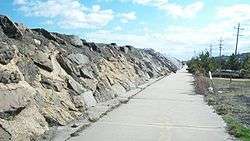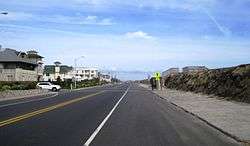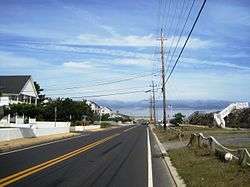Sea Bright–Monmouth Beach Seawall
The Sea Bright–Monmouth Beach Seawall is a seawall located along the Jersey Shore in the Monmouth County, New Jersey towns of Sea Bright and Monmouth Beach. It roughly runs north-south direction along 4.7 miles (7.6 km) of the barrier spit of land along the lower Sandy Hook peninsula between the Atlantic Ocean and the Shrewsbury River estuary. The use of seawalls, groins, jetties, bulkheads, revetment, and beach nourishment since the late 1800s has made the stretch of coast one of the most heavily engineered sections of ocean shorefront in the world.

.tif.png)
The effects of Hurricane Sandy wrought serious damage to the area in 2012. The reconstruction of the seawall, including new construction of 3,188 ft (972 m)[1] in gaps where it had not previously existed[2][3] began in 2017 and will be completed in 2018.[4] The storm precipitated reconsideration of seawalls and other methods of coastal protection to mitigate storm surges and sea level rise along the coast.
Geography and jurisdiction

The Sea Bright communities of Navesink Beach, Normandie, Downtown, and Low Moor and the northern portion of Monmouth Beach, known as Galilee, are located on the barrier spit of land south of the Sandy Hook peninsula (part of the Gateway National Recreation Area) between the Atlantic Ocean and the Shrewsbury River estuary. The peninsula is generally 1,000 ft (300 m) wide with an elevation of between 5 ft (1.5 m) and 10 ft (3.0 m)[5] and forms western approach to the Port of New York and New Jersey. The seawall begins south of the Highlands – Sea Bright Bridge and lies between the beach and Route 36, locally known as Ocean Avenue, which is part of the New Jersey Coastal Heritage Trail Route.
The New Jersey Department of Environmental Protection (NJDEP) Division of Coastal Engineering is responsible for coastal protection along the Jersey Shore[6] based on the New Jersey Shore Protection Master Plan developed in 1981.[7]
The United States Army Corps of Engineers (USACE) New York District coordinates the projects.[8][9] In 2016 the USACE and the Port Authority of New York and New Jersey produced a comprehensive restoration plan for the extended harbor region, which included proposals to mitigate the effects of sea-level rise through projects to restore natural areas.[10]
In the aftermath of Hurricane Sandy in 2012 funding for seawall reconstruction has been provided by the Federal Emergency Management Agency (FEMA).[11]
Seawall


Development of the area began in the 1860s when the coast became a resort.[12] Since then the use of seawalls, groins (jetties), bulkheads, revetment, and beach nourishment has made the stretch of coast one of the most heavily engineered sections of ocean shorefront in the world.[13] As described by geologist Orrin H. Pilkey the beaches have been "New Jerseyized", meaning to say that the beaches have (at one time or another) all but eroded completely leaving seawalls or the detritus of previous ones.[14]
New Jersey Southern Railroad built a 2,000-foot trestle and a seawall on the ocean side of the narrow peninsula in the 1870s, and rebuilt it again in 1881.[15] To protect Fort Hancock the U.S. Army constructed a seawall between Sandy Hook and Sea Bright in 1898. At times there was not beachfront between Sandy Hook and Long Branch.[16] The seawall was built in phases between 1914 and 1962.[17][18] The parent of NJS, the Central Railroad of New Jersey abandoned the property in 1950. The state did not opt to buy the 3.5 miles (5.6 km) strip of land that had been the railroad's right of way.[19] The state built a new seawall starting in 1946 into the 1950s.[20] By the late 1980s, the seawall had seriously deteriorated and repairs were undertaken in 1990.[21]
The region has experienced serious storms and hurricanes including those in 1938, 1944, 1950, 1955, 1960, 1962, 1972, 1976, 1984, 1985, 1991. Hurricane Sandy in 2012 devastated the shore. As of 2015, the funds allocated for the project to repair and/or replace the seawall was $34,827,594.00, 90 percent of which came from Federal Emergency Management Agency (FEMA), with the State of New Jersey funding the remaining 10 percent.[11][22] The reconstruction of the seawall, including new construction of 3,188 ft (972 m)[1] in gaps where it had not previously existed[2][3][23] is set to begin in 2017. The height of the wall is approximately 17 ft (5.2 m).[24]
Beach nourishment
CoastalStormRiskReductionProjectsStudiesMap.tif.png)
Since the Ash Wednesday Storm of 1962 beaches along the shores of the East Coast have been regularly replenished with sand pumped in from off-shore.[25][26] A multi-year project in for replacing sand began in 1994 by the USACE and originally completed in 2001 and been renourished 4 times since then. After Hurricane Sandy, approximately 5 million cubic yards of sand from the beaches in the area were washed away. The USACE in 2014 replaced more than 8 million cubic yards of sand thus restoring the project area to its original design profile.[27] The practice has become controversial due to environmental and economic concerns.[28]
Beach access

The parent of NJS, the Central Railroad of New Jersey abandoned the property in 1950. The state did not opt to buy the 3.5 miles (5.6 km) strip of the land that had been the railroad's right of way. Parts of the land came into the hands of private property owners.[19] As outlined in the Public Trust Doctrine, public access is the "ability of the public to pass physically and visually to, from and along the ocean shore", including perpendicular and linear access.[29]
Beach access on and beyond the seawall has been unclear or contentious in Sea Bright and less so in Monmouth Beach.[30][31][32] A 1993 agreement between the State of New Jersey Department of Environmental Protection and nine private beach clubs in Sea Bright allowed easements along club's oceanfront for replenishment project. that expanded narrow strip to broad sandy field. The general public was only permitted to walk along 15-foot swath of sand above the water line, but not otherwise use the beach.[33] In 2010, the Superior Court of New Jersey voided the agreement.[34] After an appeal one club which had contested was also ordered by the Appellate Court to comply.[35]
See also
References
- "Sea Bright/Monmouth Beach Sea Wall Project Delayed". 27 March 2017. Retrieved 10 May 2017.
- "Sea Wall Plan Can Move Forward". 12 April 2017. Retrieved 10 May 2017.
- "Shore town could be left vulnerable for hurricane season". Retrieved 10 May 2017.
- "Sea Bright & Monmouth Beach Seawall Repair & Construction Project". Retrieved 12 August 2018.
- Sandy Hook to Barnegat Inlet Beach Erosion Control Project GDM, Section 1, Sea Bright to Ocean Township: Environmental Impact Statement (Report). United States Army Corps of Engineers. 1990. Retrieved 8 May 2017.
- "State of New Jersey-Department of Environmental Protection-Division of Coastal Engineering". NJDEP. Retrieved 18 April 2016.
- "New Jersey Shore Protection Master Plan" (PDF). NJDEP. October 1981. Retrieved 18 April 2016. Cite journal requires
|journal=(help) - "NY District Coastal Storm Risk Reduction Projects and Studies Map". USACE. Retrieved 19 April 2017.
- Anderson, Jenny (May 18, 2013). "Rebuilding the Coastline, but at What Cost?". The New York Times. Retrieved 19 April 2017.
- Hudson-Raritan Estuary Comprehensive Restoration Plan (PDF) (Report). USACE. June 1, 2016. Retrieved 19 April 2017.
- Release Number: SRO NJ NR 069 (December 21, 2015). "FEMA Grant to Fund Seawall Project in Sea Bright and Monmouth Beach" (Press release). Federal Emergency Management Agency (FEMA). Retrieved 8 May 2017.
- Gabrielan, Randall (1998), Monmouth Beach And Sea Bright, Arcadia Publishing, ISBN 9780738549064
- Nordstrom, Karl F. (1986), Living with the New Jersey Shore, Duke University Press National Audubon Society, p. 183, ISBN 9780822306986
- Neubarth, Michael (October 1983). "A house on the beach? What beach?". Popular Science. 223 (4): 208. ISSN 0161-7370. Retrieved 8 May 2017.
"A New Jerseyized beach is a beach that has all but disappeared. All that stands in front of the buildings along the shore are sea walls and the rubble of older sea walls.
- Geffken, Rick (September 19, 2016). "Sea Bright's Seawall Saved More than the Town". Retrieved 7 May 2017.
New Jersey Southern Railroad constructed a 2,000-foot trestle and a seawall, or jetty, on the ocean side of the narrow peninsula in the 1870s. Severe storms with easterly winds, such as the Blizzard of March 1888 and a September 1889 blow, piled snow and sand dunes over the tracks, washing them out and interrupting train travel for days on end. High tides constantly washed rocks and other debris on the rails. Both trestle and seawall were continually reinforced and rebuilt after 1881.
- Titus, James G. (U.S. Environmental Protection Agency) (February 12, 2008). "Appendix C. The New Jersey Shore". CiteSeerX 10.1.1.226.6597.
In 1898 the U.S. Army built a seawall between Sandy Hook and Sea Bright to protect the operations at Fort Hancock (NPS, 2007). Over time, the seawall was extended south as far as Long Branch, and there was little or no beach along most portions of the New Jersey shore between Long Branch and Sandy Hook. During the 1970s oceanographer Orrin Pilkey and coastal geologists began to warn people around the nation about the disadvantages of what they called “New Jerseyization,” by which they meant replacing beaches with seawalls (Pilkey, et al., 1978).
Cite journal requires|journal=(help) - Spoto, MaryAnn (March 11, 2016). "Steel wall under construction for Sea Bright flood protection". The Star-Ledger. Retrieved 8 May 2017.
Built in phases between 1914 and 1962, the sea wall along Route 36 where a rail line used to run stretches 4.7 miles through Sea Bright and Monmouth Beach. But the 450-foot gap along a portion of Sea Bright's downtown never had a sea wall and state and local officials blamed that opening as one of the major reasons for the catastrophic flooding of the borough during Hurricane Sandy in 2012.
- Psuty, Norbert P.; Ofiara, Douglas D. (2002). Coastal Hazard Management: Lessons and Future Directions from New Jersey. Rutgers University Press. pp. 39–44. ISBN 9780813531502.
- Spoto, Mary Anne (July 6, 2011). "It's not easy to enjoy a day at the beach in some Jersey Shore towns, where access is made formidable". The Star-Ledger. Retrieved 10 May 2017.
...when the Central Railroad of New Jersey abandoned the rail line in Sea Bright...homeowners got the land directly across Route 36 from their property lines after the state did not act on an offer to buy the 3½-mile strip from the railroad for $250,000 in 1950 for a potential road-widening project.
- Rankin, JK (1952). "Development of the Jersey Shore". Retrieved 5 May 2017.
In SeaBright alone,two miles of stone seawall were constructed in 1946...
Cite journal requires|journal=(help) - Gornitz, Vivien; Couch, Stephen; Hartig, Ellen K. (2001). "Impacts of sea level rise in the New York City metropolitan area" (PDF). CUNY: 72.
Sea Bright, a residential community located on the southern part of the Sandy Hook spit, on the northern New Jersey shoreline, has a long history of exposure to storm and wave action. Starting in 1913, a set of 85 groins were constructed throughout the area, and in 1922, a 120-m breakwater was completed in Sea Bright. In the 1950s, a seawall was built between Sea Bright and Monmouth Beach (Gorman and Reed, 1989). By the late 1980s, the seawall had seriously deteriorated and repairs were undertaken in 1990 (Bocamazo, 1991).
Cite journal requires|journal=(help) - "New Jersey – $28 Million Allocated For Sea Bright, Monmouth Beach Seawall Repairs - Coastal Engineering News & Subscription List". coastalnewstoday.com. Retrieved 9 May 2017.
- "Borough Outlines Sea Wall Repair Specs". 17 September 2014. Retrieved 11 May 2017.
- Bush, David M. (1996). Living by the rules of the sea. Pilkey, Orrin H., 1934-, Neal, William J. Durham, N.C.: Duke University Press. pp. 68. ISBN 0-8223-1801-6. OCLC 33948273.
- Muka, Samantha (August 11, 2015). "Building Beaches: Beach Nourishment in the United States". Retrieved 10 April 2017.
- Seabrook, John (July 22, 2013). The Beach Builders. The New Yorker. Retrieved 18 April 2017.
- "Sea Bright to Manasquan, NJ Beach Coastal Storm Risk Management and Erosion Control Project". USACE. Retrieved 8 May 2017.
This project has been in the periodic renourishment phase since original completion. The initial construction of this project was initiated in 1994 and completed (with the exception of Elberon, Deal, Allenhurst, and Loch Arbour) in 2001. Since this time, Federal funding has been available for 4 limited renourishment contracts in areas of Monmouth Beach, Sea Bright, Long Branch, and a very small portion of Spring Lake. Additional renourishment contracts will be awarded when Federal and non-Federal funding is available for the remaining duration of the authorisation. After Hurricane Sandy, the beaches in the project area lost roughly 5 million cubic yards of sand. The Corps of Engineers has repaired and restored this project after Hurricane Sandy through the Flood Control and Coastal Emergencies Act (Public Law 84-99) and the Disaster Relief Appropriations Act of 2013, Public Law 113-2). The work entailed replacing the sand lost during the storm as well as restoring the project to its original design profile. This effort was done through four contracts and involved the placement of more than 8 million cubic yards of sand. This repair and restore effort is 100 percent federally funded and was completed in the Summer of 2014
- Moore, Kirk (September 29, 2016). "Money and Sand:Will there be enough for New Jersey's Beaches". NJ Spotlight. Retrieved 19 April 2017.
- "NJ Public Access Rights". NJDEP. Retrieved 10 May 2017.
Lands and waters subject to public trust rights are tidal waterways and their shores, including both lands now or formerly below the mean high water line, and shores above the mean high water line. Tidal waterways and their shores are subject to the Public Trust Doctrine and are held in trust by the State for the benefit of all the people, allowing the public to fully enjoy these lands and waters for a variety of public uses. Public trust rights include public access which is the ability of the public to pass physically and visually to, from and along the ocean shore and other waterfronts subject to public trust rights and to use these lands and waters for activities such as navigation, fishing and recreational activities including, but not limited to, swimming, sunbathing, surfing, sport diving, bird watching, walking, and boating. Public trust rights also include the right to perpendicular and linear access.
- "Bonnie J. McCay, Debbie Mans, Satsuki Takahashi, and Sheri Seminski. (2005) Public Access and Waterfront Development in New Jersey: From the Arthur Kill to the Shrewsbury River" (PDF). Retrieved 12 August 2018.
- Interboro Partners (September 25, 2013). "Sea Bright and the Sea Wall". Retrieved 10 May 2017.
- Cheslow, Jerrsy (October 6, 2002). "If You're Thinking of Living In/Monmouth Beach; A Town Where Water Lovers Abound". The New York Times. Retrieved 10 May 2017.
- Penaaug, Richard Perez (August 12, 2012). "Along the Jersey Shore, a Struggle to Get to the Sand". The New York Times. Retrieved 10 May 2017.
- Murray, Brian T. (July 9, 2010). "N.J. Superior Court orders private Sea Bright beach to provide public access". The Star-Ledger. Retrieved 10 May 2017.
- Spoto, MaryAnn (September 28, 2012). "N.J. appellate panel tells Sea Bright club it must open beach to everyone". The Star-Ledger. Retrieved 10 May 2017.
Further reading
- 2016 Floodplain Management Plan (draft) Borough of Monmouth Beach, Monmouth County, New Jersey
- "Strategic Recovery Planning" (PDF). Borough of Sea Bright. 2013.
- "Sea Bright, NJ". Edward J. Bloustein School of Planning and Public Policy. 2013.
- Hafner, Steven (2008). Beach Stabilization Structure & Beach Nourishment Alternatives (PDF) (Report). Richard Stockton College of NJ, Coastal Research Center.
- MaryAnn Spoto, MaryAnn Spoto (October 1, 2015). "A post-Sandy lesson: How the Shore has changed since the last big storm". The Star-Ledger.
- Chris Kirkham , John Rudolf (December 12, 2012). "Jersey Shore Development Failures Exposed By Hurricane Sandy". The Huffington Post.
- Dean, Cornelia (2005), Against the Tide: The Battle for America's Beaches, Columbia University Press, p. 57, ISBN 9780231500111
- "Related to FEMA DR‐NJ 4086 Declared for Hurricane Sandy Beach‐Dune Performance Assessment of New Jersey Beach Profile Network (NJBPN) Sites Between Deal and Sea Bright, New Jersey" (PDF). Stockton University. December 2012.
- "State of the Beach New Jersey". beachapedia.org.
- Shrewsbury River Basin, Sea Bright, New Jersey Coastal Storm Risk Management Feasibility Study